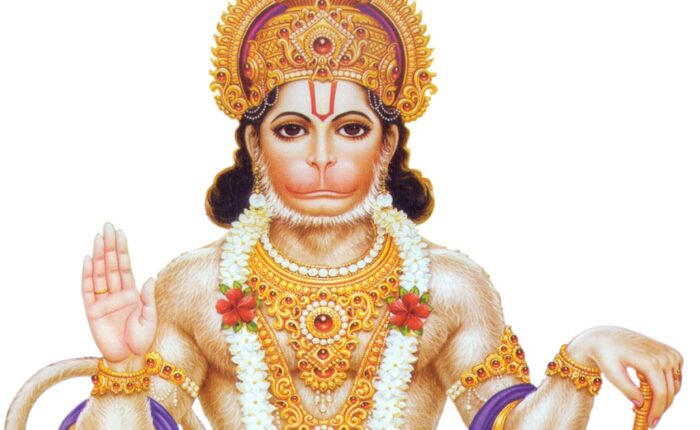Sri Hanuman Ji in Tamil and Telugu Scriptures

In both Tamil and Telugu-speaking areas, the character of Hanuman and his roles are well known. However, the literary developments in both areas were not similar. An introductory account only can be given in this article.
Tamil Lands
The literary developments in Tamil areas are much older. A vast literature exists on Alvers and Naynars and the records of three Sangams some under Rishi Agastya. Valmiki Ramayan which pre-dates Tulsi Ramayan by many centuries provided the historical basis of the composition of a Tamil Ramayan entitled “Ramavataram”. The great Tamil poet Kamban composed this epic which is called Kamban Ramayan. There is a uniqueness in the style of narration in Kamban Ramayan. A short article by Sri R. Venkatratnam is available in the Hanuman Ank published by Gita Press, Gorakhpur in which the performance of actions by Hanuman in Lanka has been described but there is no mention of any name in the extract from Kamban Ramayan. Every piece of information is indicative. The language and script in the Ramayan is Tamil which has been transliterated into Devanagari by the author of the article in Hanuman Ank. A transliteration from Devanagari to Roman script is available herewith. The language is Tamil.
“Anjile Onru Petran Anjile Onaittavi
Anjile Onru Araga Ariyarak Kag Egi
Anjile Onru Petra Anangu Kandu Ayalar Uril
Anjile Onrai Vaittan Avan Emmai Alittukkapyan”
In this extract, the name of Hanuman does not appear at all. Anju (Anjile) appears five times which stands for Pancha Mahabhut, Vayu (air), Jal (water), Akash (ether), Prithvi (earth) and Agni (fire). Onru stands for one. Ailar Ur stands for foreign lands. The meaning of the extract, translated into English will be broadly like the following.
“Son of one of the Five
After crossing one of the five
Through the route of one of the five
As an Aryan arriver
Seeing the daughter of one of the five
In a foreign land
Used one of the five there
Be merciful and protect us.”
The well-known story is that Hanuman, the Vayu Putra, crossed the ocean (Jal) and arrived in Lanka (a foreign land), met with Sita (daughter of the earth) and used fire for Lanka Dahan. He followed the route through the air.
Thus, in Tamil lands also the heroics of Hanuman have been described in the Kamban Ramayan. People pray to him for protection and mercy.
Telugu Lands:
Literary developments in Telugu lands somewhat lagged behind Tamil. However, the pervasiveness of Sanskrit was beyond doubt. Valmiki Ramayan must have arrived very early in Telugu lands which resulted in the composition of Telugu Ramayans. The characterization of Ram and Hanuman in Telugu Ramayans also must have remained in conformity with the characterization in Valmiki Ramayan.
An article on Hanuman in Telugu Ramayans by Sri Challapalli Bhaskar Ramkrishnamacharyullu can be seen in the Hanuman Ank published by Gita Press Gorakhpur. This article talks about three Telugu Ramayans.
- Bhaskar Ramayan has been composed by Hullakki Bhaskarudu in which Valmiki Ramayan’s story re-appears in slightly varying forms.
- Ranganath Ramayan has been composed by Gaunabuddharaju, which is regarded as a translation of Valmiki Ramayan in Telugu.
- The Molla Ramayan has been composed by the poetess Atukuri Molla which conforms to the stories of Valmiki Ramayan with minor variations.
All the three Telugu Ramayans mentioned belong to the 14th century C.E. which pre-dates them from Ram Charita Manas of Tulsidas. In Telugu Ramayans also the details regarding the following are available.
- Birth of Hanuman as Vayu Putra from the wombs of Anjana is available.
- Hanuman Tapasya to Bramha for the award of a lord like Vishnu who could see his invisible ornaments has been described.
- Ram-Hanuman contact in the Kishkindha area has been fully covered with Sugreeva etc.
- Entrusting the ring by Ram for Sita after making contact with her in search operations is similar. The Molla Ramayan also mentions giving directions to Hanuman for bringing back Sita’s Chudamani in return.
- Crossing of the Ocean by Hanuman and other details while arriving in Lanka are available.
- Contact with Sita and related details are available.
- The destruction of Ashok Vatika of Ravan has been described. There is detailed coverage in all three Ramayans.
- Lanka Dahan has been covered in detail. Sita had prayed to Agni Deva not to harm Hanuman when his tail was being burnt under oiled bandages.
- The uprooting of Dronachal Parbat for obtaining Sanjeevini Booti has also been described. The obstruction created by Kaalnemi has also been covered.
- The Coronation of Ram after Lanka Victory was with the assistance of Hanuman because he fetched water from oceans for Rajyavishek. Thereafter, he decides to stay with Prabhu Ram of Ayodhya.
Thus, the reach of Ramayan and the main characters Ram, Sita and Hanuman seems all pervasive in India.
I am a Vedic astrologer by profession. I have done Jyotish Acharya from Bhartiya Vidya Bhawan. I am devoted to my Sadguru Shri Sai Nath of Shirdi. I am also interested in spirituality. I love to guide people.